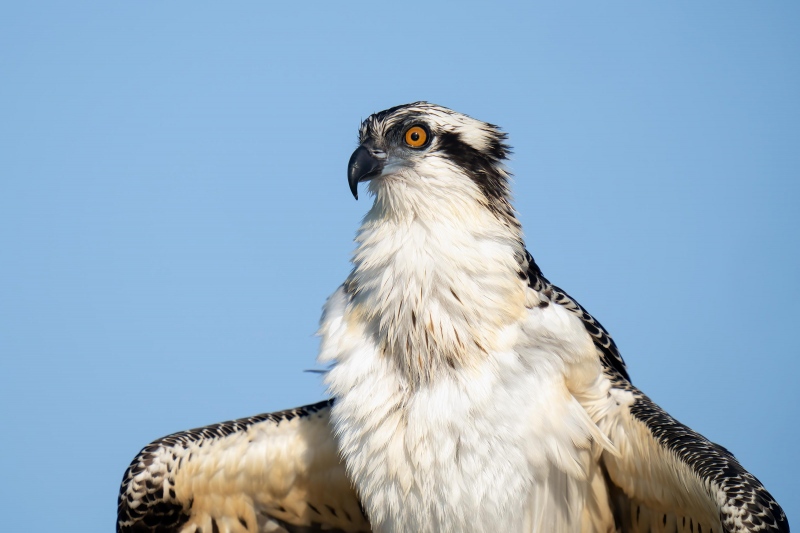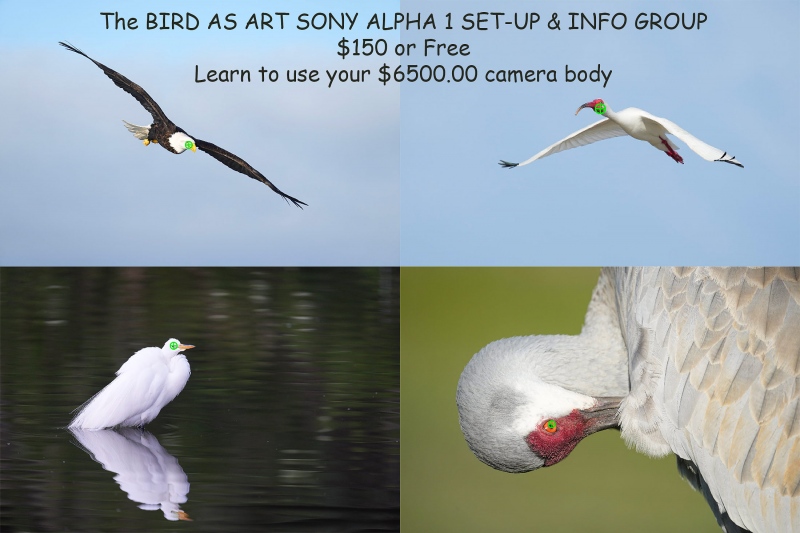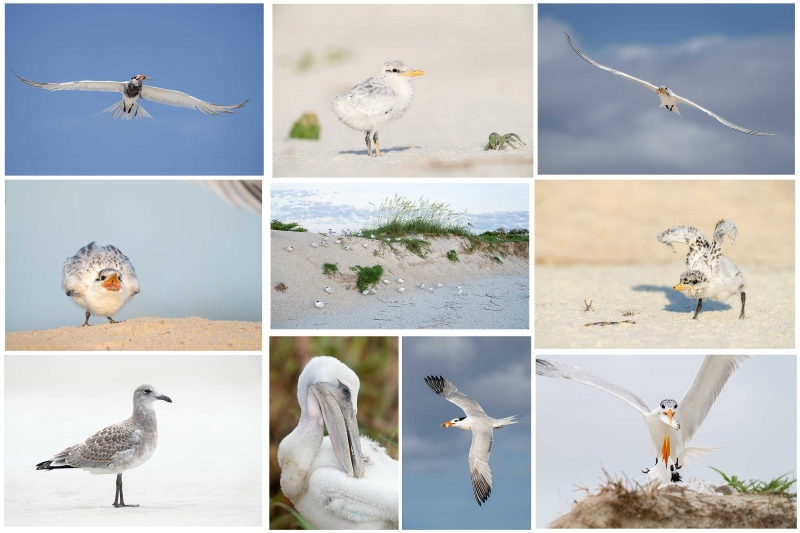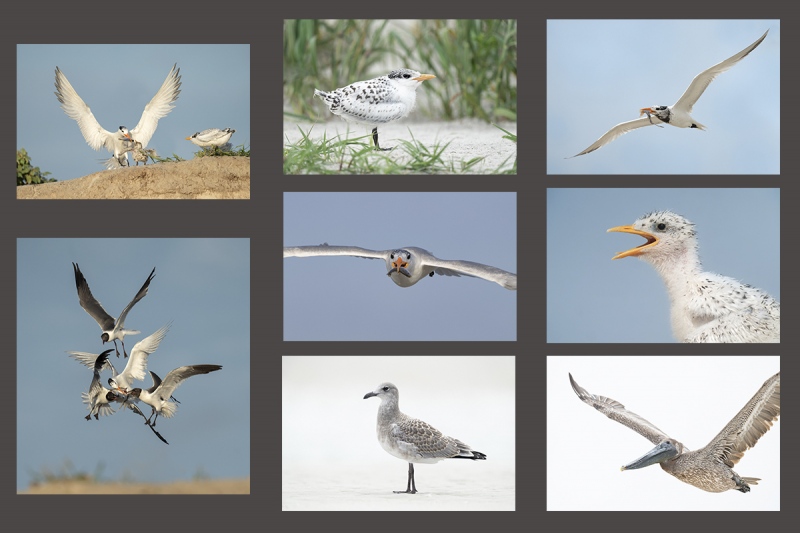Your Call?
What do you think of today’s featured image?
What’s Up?
Monday morning was superbly perfect for bird photography with sunny skies and a variable east wind. I did not, however, do much in the first hour. Walking the pier, I created some blurs of two juvie Ospreys playing tag and tried and failed with the Green Herons. I drove around for a while, spent a few minutes with the single colt crane family, made some caracara photos, and then took a second walk on the pier with much better results — I created today’s very special featured image. Read the whole story below. And be sure to click on the image to view the spectacular high-res version.
My new LG washer and dryer were installed in the morning, and my central air repaired in the afternoon. So all is cool at 4041 Granada Drive 🙂
Today is Tuesday 21 June 2022. The forecast is for partly cloudy early with increasing cloudiness and a northeast wind. For a change, I will be heading down to the lake very early. Wherever you are and whatever you are doing, I hope that you too have a great day. This blog post took about an hour to prepare and makes ninety-six days in a row with a new one.
Please remember to use the B&H and Amazon links that are found on most blog pages and to use the BIRDSASART discount code at checkout when purchasing your new gear from Bedfords to get 3% back on your credit card and enjoy free second-day air FedEx. Please, also, consider joining a BAA IPT. You will be amazed at how much you will learn!
BIRDS AS ART Image Optimization Service (BAA IOS)
Send a PayPal for $62.00 to birdsasart@verizon.net or call Jim at 863-692-0906 and put $62.00 on your credit card. Pick one of your best images and upload the raw file using a large file sending service like Hightail or DropBox and then send me the link via e-mail. I will download and save your raw file, evaluate the exposure and sharpness, and optimize the image as if it were my own after converting the raw file in Adobe Camera Raw. Best of all, I will make a screen recording of the entire process and send you a link to the video to download, save and study.
Another Induro GIT 304L Price Drop
Amazingly, we have two, brand-new-in-the-box Induro GIT 304L tripods in stock. They are $699.00 each (were $799.00) and the price now includes the insured ground shipping to the lower 48 states. Weekday phone orders only: 863-692-0906.
|
|
|
This image was created on 20 June 2022 down by the lake near my home at Indian Lake Estates, FL. Standing on the pier, I used the handheld Sony FE 400mm f/2.8 GM OSS lens with the Sony FE 2.0x Teleconverter, and The One, the Sony Alpha 1 Mirrorless Digital Camera). The exposure was determined using Zebra technology with ISO on the Thumb Wheel. ISO 800. 1/3200 sec. at f/5.6 (wide open) in Manual mode. When evaluated in RawDigger, the raw file brightness was determined to be perfect. AWB at 7:53:29am on sunny morning with an east wind. Tracking: Spot S with Bird Face/Eye detection enabled performed just fine. Be sure to click on the image to enjoy a high-res version. Juvenile Osprey perched on low light pole. |
The Stealthy Approach
For the past few weeks, fledged Ospreys have been all over the pier in the mornings. They sit on the wooden railing and perch on curved metal atop the light poles. I have seen as many as eight on the pier at one time, and have been dreaming of getting close to a bird on a light pole as the poles are only about fifteen feet tall. Fortunately, the light poles are on the left (south) side of the pier — if you can get fairly close to the pole, you can get close to light angle as the sun is in the northeast in the early morning. Note that it is easier to get close to a bird on one of the poles than it is to get close to one on the pier railing because the additional height gives them some sense of protection.
Working with the handheld 400mm f/2.8 GM lens (Fat Boy) with the 1.4x CT I walked west on the pier. There was a handsome young Osprey sitting on a light pole. I approached slowly, but it flew. Thinking that there was one chance in a hundred that it might return to the same perch, I removed the TC and set the exposure for f/2.8. Cops came! I was so close to the pole when the bird re-landed that I clipped the wings in most of the frames. Slowly, I reached into my fanny pack, grabbed the 2X TC, mounted it on the lens, adjusted the exposure for the new aperture — f/5.6, and began making images. As I was adding the 2X, the young bird drooped its wings and held them out to the side as if attempting to dry them.
I’d make a few images and then take a small step or two toward the bird. My movements were so slow as to be barely perceptible. Rinse and repeat. I was so excited that I could barely breathe. Toady’s featured image (a small crop from the left and from above) was created at 13.6 meters (44.6 feet). I made the last image when I was only 11.11 meters from the bird — 36.5 feet! That’s close. I tried one more step and the young bird had had enough.
Sony a1 Firmware V1.30 Update
I updated both of my a1 bodies to Firmware V1.30. As hard as it is to believe, Bird Eye/Face detection has improved significantly. I am seeing the tiny green box far more often. I will be sharing additional details with the SONY Alpha a1 Set-up and Info Group in e-mail D this week.
Funny
A photographer whom I met at Gatorland e-mailed asking about the SONY Alpha a1 Set-up Guide and Info Group. I sent her the details.
She replied:
Settings for birds and wildlife $150?
I wrote her back:
Funny how folks spend $7k on a camera body — not to mention a telephoto lens or two, but balk at spending $150 to learn how to use it efficiently. Folks who subscribe to the blog and used my links to purchase the a1 received got the guide for free.
With love, artie
|
|
|
Click on the image to better see the green eye-AF boxes in action. Sony Alpha 1 Flight Photography AF Points! |
The SONY Alpha a1 Set-up Guide and Info Group: $150.00 (or Free)
The SONY Alpha a1 Set-up Guide and Info Group is going great guns as more and more folks chime in with thoughtful questions and experience-based answers. As the a1 is becoming more readily available, more and more folks are getting their hands on this amazing body. By June 1, 2022, the group was up to an astounding 124 lucky and blessed folks. (More than a few folks own two or more a1 bodies! Early on, we discussed the myriad AF options. I gave my opinion as to the best one for flight and general bird photography. The best news is that everyone in the group receives an e-mail that includes a .DAT file with my a1 settings on it, and explicit directions on how to load my settings onto your a1; talk about convenience! I am now offering a .DAT file compatible with firmware update 1.20. Your entry into the group includes a consolidated Sony a1 CAMSETA2 INFO & GUIDE. New a1 folks will now receive four e-mails instead of the previous 28! You will see new e-mails as they are published. Simply put, this e-mail guide is an incredible resource for anyone with an a1.
All who purchased their Alpha 1 bodies via a BAA affiliate link — B&H or Bedfords — will receive a free Sony Alpha a1 Set-Up Guide and free entry into the Info Updates group after shooting me their receipts via e-mail. (Note: it may take me several days to confirm B&H orders.). Others can purchase their guide here in the BAA Online Store.
Flight Photography at Jacksonville Till You Can’t Lift Your Lens! with Arthur Morris/BIRDS AS ART
Join me on the beach at Huguenot Memorial Park to learn about photographing terns in flight. 8,000 pairs of Royal Terns nest there and there are birds in the air all the time, often carrying all kinds of fish and crabs for their young. Learn about how the relationship between the wind and the sun impacts flight photography and about the best gear for shooting birds in flight. Join me on a workshop at Jacksonville this summer.
Cute & Beautiful: Photographing Chicks in Jacksonville, FL with Arthur Morris/BIRDS AS ART
There is an amazing beach near Jacksonville, FL where 8,000 pairs of Royal Terns and 12,000 pairs of Laughing Gulls (along with a few other species) breed each summer. As this video shows, photographing the chicks is easy in the summer. And there is tons of great flight photography as well. If you want to improve your bird photography skills, consider joining me on an Instructional Photo-Tour (IPT).
|
|
|
Click on the composite image to enjoy the incredible quality of the hi-res JPEG. Clockwise from upper left clockwise and back around to the center: Royal Tern in flight with squid for chick; Royal Tern chick on beach; Royal Tern in flight with shrimp for young; Royal Tern chick — double overhead wing stretch; Royal Tern landing with greenback for chick; Royal Tern in flight with juvenile mahi mahi for chick; Brown Pelican — large chick preening; Laughing Gull in fresh juvenal plumage; Royal Tern chick begging; Many Royal Terns with many chicks on face of dune. |
Jacksonville IPT #1: 4 FULL DAYS — the afternoon of FRI 1 JULY thru the morning of TUES 5 July 2022: $2099.00 (Limit 6 photographers/Openings: 5)
Jacksonville IPT #2: 4 FULL DAYS — the afternoon of FRI 15 JULY thru the morning of TUES 19 July 2022: $2099.00 (Limit 6 photographers/Openings: 5)
The first three folks to register on each trip can ride to and on and from the beach with me for no charge.
Jacksonville IPT #2: 4 FULL DAYS — the afternoon of FRI 15 JULY thru the morning of TUES 19 July 2022: $2099.00 (Limit 6 photographers/Openings: 5)
The first three folks to register on each trip can ride to and on and from the beach with me for no charge.
I first visited the breeding bird colony at Jacksonville in late June 2021. I was astounded. There were many thousands of pairs of Royal Terns nesting along with about 10,000 pairs of Laughing Gulls. In addition to the royals, there were some Sandwich Terns nesting. And there are several dozen pairs of Brown Pelicans nesting on the ground. Flight photography was non-stop astounding. And photographing the tern chicks was relatively easy. Folks could do the whole trip with the Sony 200-600, the Canon 100-500 RF, or the Nikon 500 PF or 200-500 VR. With a TC in your pocket for use on sunny days. Most of the action is within 100 yards of where we park (on the beach). As with all bird photography, there are times when a super-telephoto lens with either TC is the best tool for the job.
Morning sessions will average about three 1/2 hours, afternoon sessions about 1 1/2 hours. On cloudy mornings with favorable winds, we may opt to stay out for one long session and skip the afternoon, especially when the afternoon forecast is poor. Lunch is included on the first three days of the IPT and will be served at my AirBnB. We will do image review and Photoshop after lunch.
We will be based somewhere west and a bit north of Jacksonville where there are many AirBnB possibilities. The deposit is $599.00. Call Jim at the office any weekday at 863-692-0906 to pay by credit card. Balances must be paid by check.
|
|
|
Click on the composite image to enjoy the incredible quality of the hi-res JPEG. Clockwise from upper left clockwise and back around to the center: Royal Tern feeding chick; Royal Tern/4-week-old chick; ink-stained Royal Tern in flight with squid for chick; Royal Tern/3-week-old chick begging; Brown Pelican in flight on white sky day; fresh juvenile Laughing Gull on clean beach; Laughing Gulls stealing fish from Royal Tern; tight shot of Royal Tern in flight with fish for young. |
What You Will Learn on a Jacksonville IPT
- 1- First and foremast you will learn to become a better flight photographer. Much better.
- 2-You will learn the basics and fine points of digital exposure. Nikon and Canon folks will learn to get the right exposure every time after making a single test exposure, and SONY folks will learn to use Zebras so that they can be sure of making excellent exposures before pressing the shutter button.
- 3- You will learn to work in Manual exposure mode even if you fear it.
- 4- You will learn to evaluate wind and sky conditions and understand how they affect bird photography, especially the photography of birds in flight.
- 5- You will learn several pro secrets (for each system) that will help you to become a better flight photographer.
- 6- You will learn to zoom out in advance (because the birds are so close!) 🙂
- 7- You will learn how to approach free and wild birds without disturbing them.
- 8- You will learn to spot the good and the great situations.
- 9- You will learn to understand and predict bird behavior.
- 10- You will learn to design pleasing images by mastering your camera’s AF system.
- 11- You will learn to choose the best perspective.
- 12- You will learn to see and control your backgrounds.
- 13- You will learn to see and understand the light.
- 14- You will learn to see and create pleasing blurs in pre-dawn situations.
- 15- You will learn to be ready for the most likely event.
The best news is that you will be able to take everything you learn home with you so that you will be a better photographer wherever you are and whenever you photograph.
Typos
With all blog posts, feel free to e-mail or to leave a comment regarding any typos or errors.


















Typo:
I have seen as mantas eight
Thanks and fixed with love.
artie
Thanks, all, for your kind comments. I love this one too.
with love, artie
Love the photo.
Beautiful!
That’s pretty impressive that you could get within 35′ of a juvenile osprey without some sort of hide or ghillie. Sometimes, one can get pretty close, though once the camera comes up, they usually bolt. Nice image.
Agree. Some of the juvie (and all of the adults) fly away when you get within 100 yards. But not all of them.
with love, artie
The osprey image is so sharp I can see what he had for lunch on his breast feathers. Ha. Great image !
A handsome juvenile osprey image indeed!
Great image, Artie. When I had a boat in Chesapeake Bay I coul easily get within 30-40 feet of adult and juvenile ospreys nesting on the channel markers. They were quite used to boats going by. They got a bit nervous if I stopped, so I would photograph them as I went by slowly. Also easy to get on sun angle.
Hi Artie, I really like the Osprey juvenile image. Lovely colors and feather detail. Wonderful things happen when one can get that close to a bird. Thank you for sharing.